Abstract
The reproducibility of pulmonary function tests in the laboratory and in a mobile field survey vehicle has been studied. Groups of laboratory workers were studied at base and a random sample of 38 coalminers was examined in the mobile laboratory. The intra-subject variability of some newer tests of lung function, including closing volume and maximum flow at low lung volumes, has been compared with that of well-established tests, such as lung volumes and forced expiratory volume from two measurements made more than one day apart. Most measurements were slightly less reproducible in the study of coalminers than in the laboratory personnel. Conventional tests, such as forced expiratory volume in one second, lung volumes, single breath CO transfer factor, and exercise ventilation were very reproducible, the coefficients of variation (cov) being generally between 5% and 10%. The closing volume test, maximum expiratory flow at low lung volumes, and the single breath N2 index were less reproducible: cov between 15% and 39% in the miners. The forced expired time and volume of isoflow, measured only on laboratory workers, however, exhibited greater reproducibility than previously reported (cov = 10% and 15% respectively). It is suggested that, when assessing the repeatability of lung function tests, account should be taken of the circumstances in which the intra-subject variability was measured.
Full text
PDF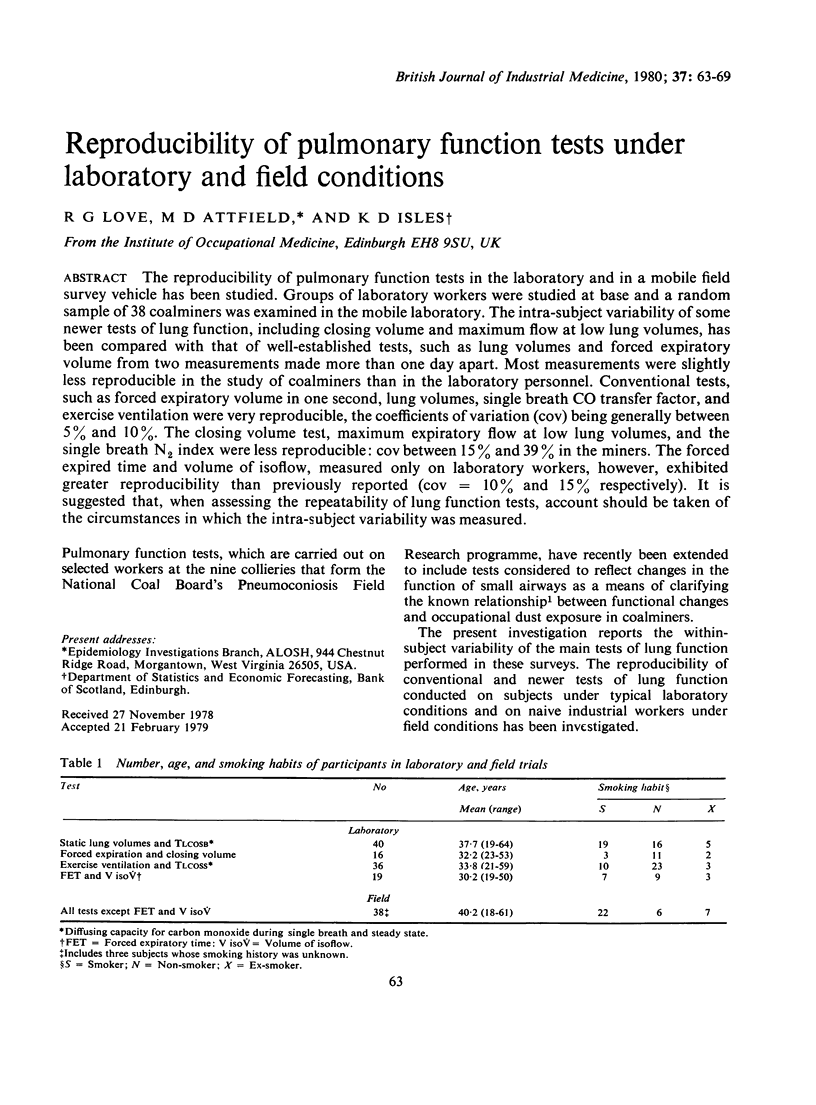
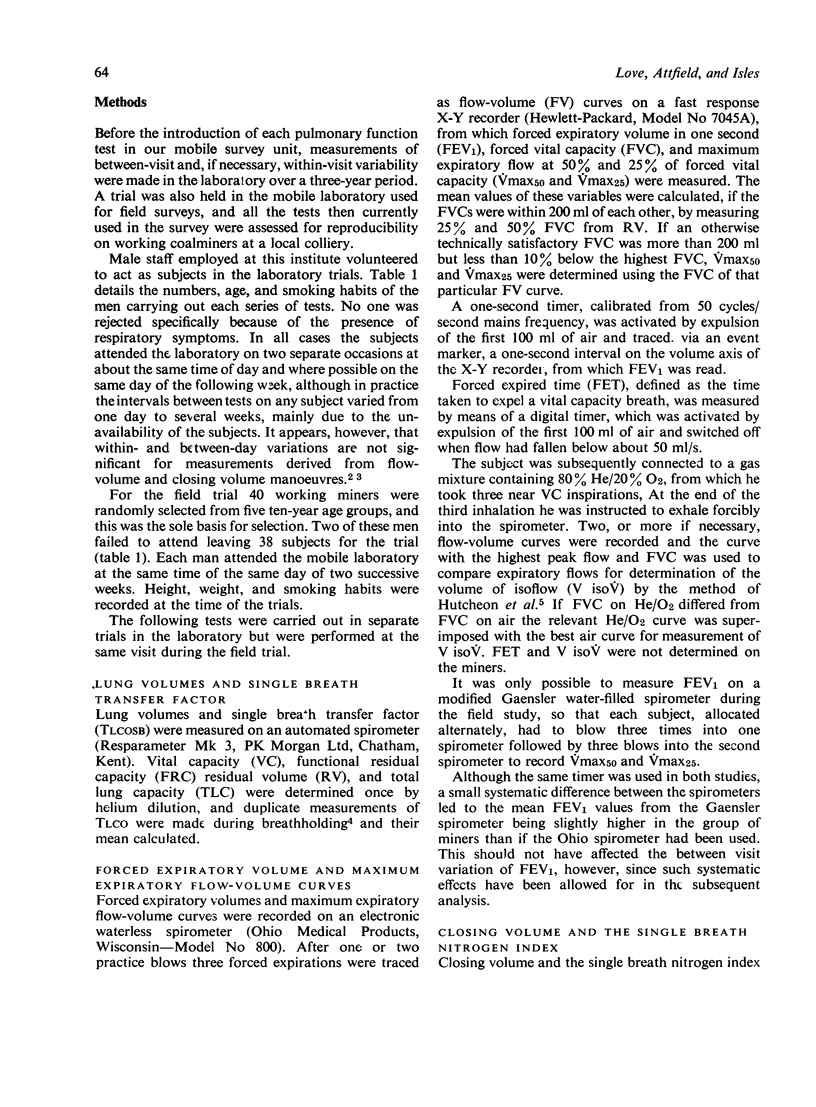
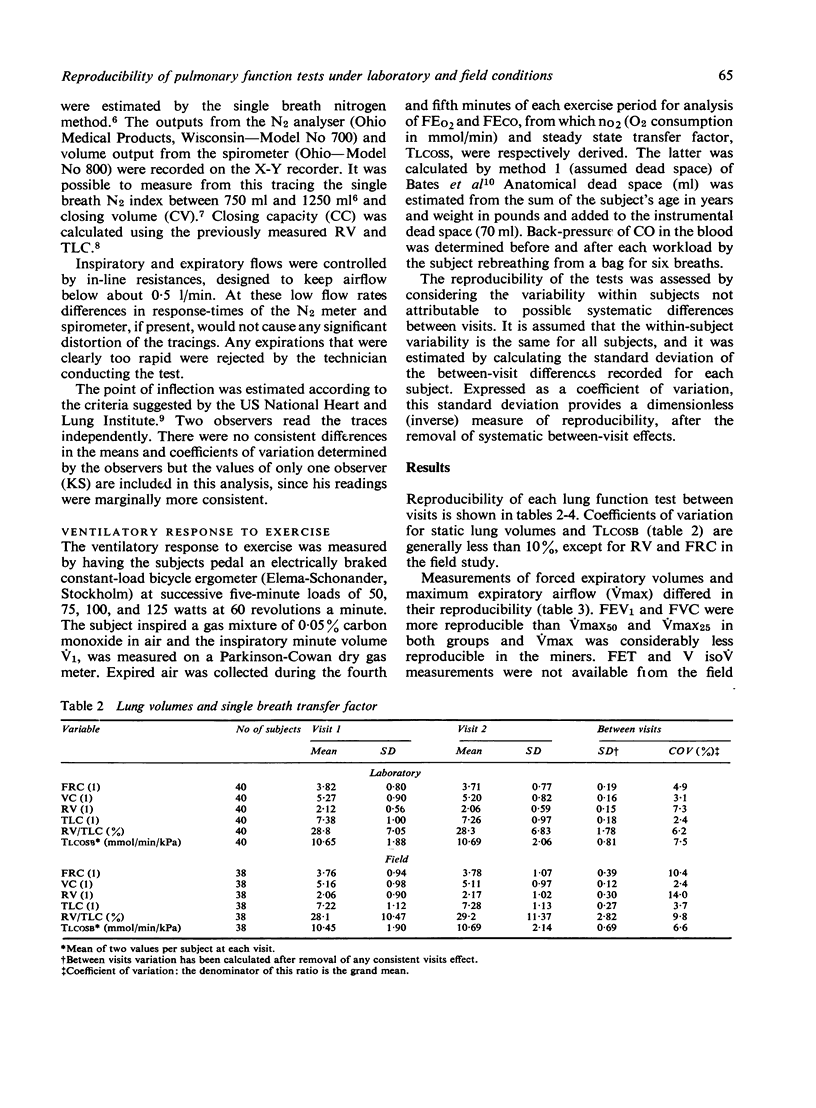

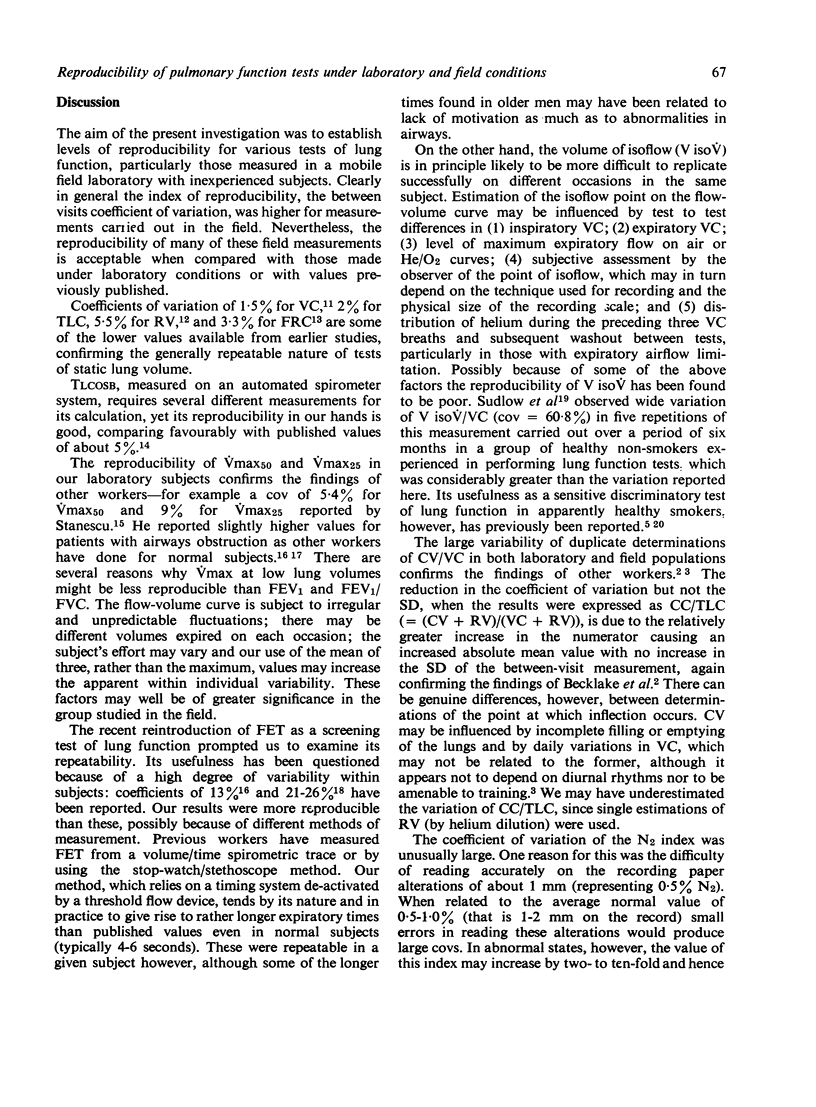
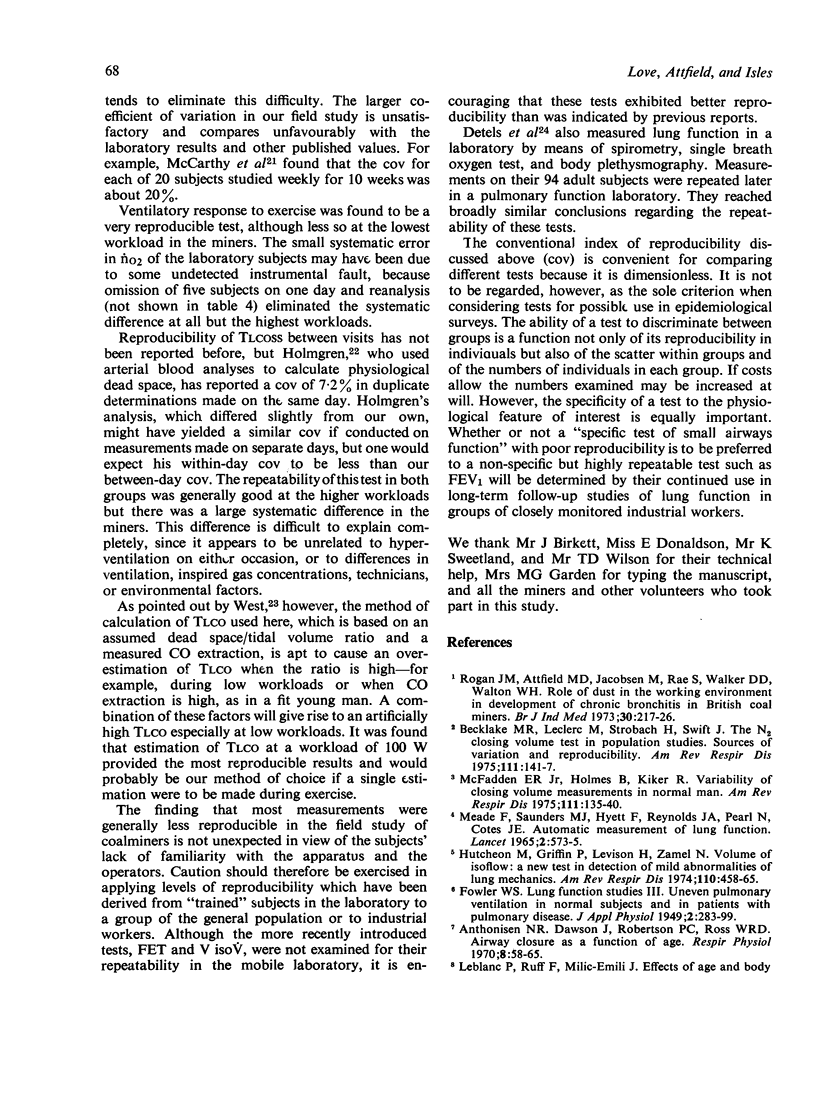
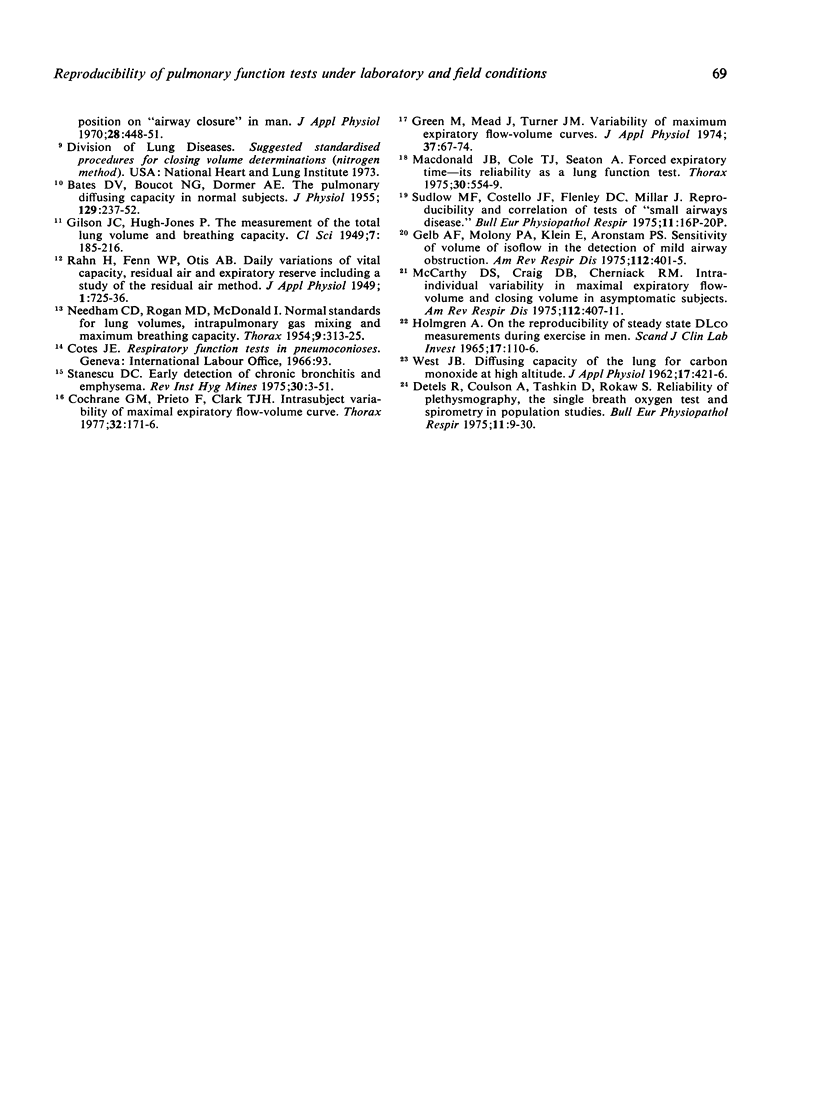
Selected References
These references are in PubMed. This may not be the complete list of references from this article.
- Anthonisen N. R., Danson J., Robertson P. C., Ross W. R. Airway closure as a function of age. Respir Physiol. 1969 Dec;8(1):58–65. doi: 10.1016/0034-5687(69)90044-9. [DOI] [PubMed] [Google Scholar]
- BATES D. V., BOUCOT N. G., DORMER A. E. The pulmonary diffusing capacity in normal subjects. J Physiol. 1955 Aug 29;129(2):237–252. doi: 10.1113/jphysiol.1955.sp005350. [DOI] [PMC free article] [PubMed] [Google Scholar]
- Becklake M. R., Leclerc M., Strobach H., Swift J. The N2 closing volume test in population studies: sources of variation and reproducibility. Am Rev Respir Dis. 1975 Feb;111(2):141–147. doi: 10.1164/arrd.1975.111.2.141. [DOI] [PubMed] [Google Scholar]
- Cochrane G. M., Prieto F., Clark T. J. Intrasubject variability of maximal expiratory flow volume curve. Thorax. 1977 Apr;32(2):171–176. doi: 10.1136/thx.32.2.171. [DOI] [PMC free article] [PubMed] [Google Scholar]
- Detels R., Coulson A., Tashkin D., Rokaw S. Reliability of plethysmography, the single breath oxygen test, and spirometry in population studies. Bull Physiopathol Respir (Nancy) 1975 Jan-Feb;11(1):9–30. [PubMed] [Google Scholar]
- FOWLER W. S. Lung function studies; uneven pulmonary ventilation in normal subjects and in patients with pulmonary disease. J Appl Physiol. 1949 Dec;2(6):283–299. doi: 10.1152/jappl.1949.2.6.283. [DOI] [PubMed] [Google Scholar]
- Gelb A. F., Molony P. A., Klein E., Aronstam P. S. Sensitivity of volume of isoflow in the detection of mild airway obstruction. Am Rev Respir Dis. 1975 Sep;112(3):401–405. doi: 10.1164/arrd.1975.112.3.401. [DOI] [PubMed] [Google Scholar]
- Green M., Mead J., Turner J. M. Variability of maximum expiratory flow-volume curves. J Appl Physiol. 1974 Jul;37(1):67–74. doi: 10.1152/jappl.1974.37.1.67. [DOI] [PubMed] [Google Scholar]
- Hutcheon M., Griffin P., Levison H., Zamel N. Volume of isoflow. A new test in detection of mild abnormalities of lung mechanics. Am Rev Respir Dis. 1974 Oct;110(4):458–465. doi: 10.1164/arrd.1974.110.4.458. [DOI] [PubMed] [Google Scholar]
- Leblanc P., Ruff F., Milic-Emili J. Effects of age and body position on "airway closure" in man. J Appl Physiol. 1970 Apr;28(4):448–451. doi: 10.1152/jappl.1970.28.4.448. [DOI] [PubMed] [Google Scholar]
- Macdonald J. B., Cole T. J., Seaton A. Forced expiratory time--its reliability as a lung function test. Thorax. 1975 Oct;30(5):554–559. doi: 10.1136/thx.30.5.554. [DOI] [PMC free article] [PubMed] [Google Scholar]
- McCarthy D. S., Craig D. B., Cherniack R. M. Intraindividual variability in maximal expiratory flow-volume and closing volume in asymptomatic subjects. Am Rev Respir Dis. 1975 Sep;112(3):407–411. doi: 10.1164/arrd.1975.112.3.407. [DOI] [PubMed] [Google Scholar]
- McFadden E. R., Jr, holmes B., Kiker R. Variability of closing volume measurements in normal man. Am Rev Respir Dis. 1975 Feb;111(2):135–140. doi: 10.1164/arrd.1975.111.2.135. [DOI] [PubMed] [Google Scholar]
- Meade F., Saunders M. J., Hyett F., Reynolds J. A., Pearl N., Cotes J. E. Automatic measurement of lung function. Lancet. 1965 Sep 18;2(7412):573–575. doi: 10.1016/s0140-6736(65)90874-3. [DOI] [PubMed] [Google Scholar]
- NEEDHAM C. D., ROGAN M. C., McDONALD I. Normal standards for lung volumes, intrapulmonary gas-mixing, and maximum breathing capacity. Thorax. 1954 Dec;9(4):313–325. doi: 10.1136/thx.9.4.313. [DOI] [PMC free article] [PubMed] [Google Scholar]
- Rogan J. M., Attfield M. D., Jacobsen M., Rae S., Walker D. D., Walton W. H. Role of dust in the working environment in development of chronic bronchitis in British coal miners. Br J Ind Med. 1973 Jul;30(3):217–226. doi: 10.1136/oem.30.3.217. [DOI] [PMC free article] [PubMed] [Google Scholar]
- Stanescu D. C. Early detection of chronic bronchitis and pulmonary emphysema. Rev Inst Hyg Mines (Hasselt) 1975;30(1):1–51. [PubMed] [Google Scholar]
- WEST J. B. Diffusing capacity of the lung for carbon monoxide at high altitude. J Appl Physiol. 1962 May;17:421–426. doi: 10.1152/jappl.1962.17.3.421. [DOI] [PubMed] [Google Scholar]


